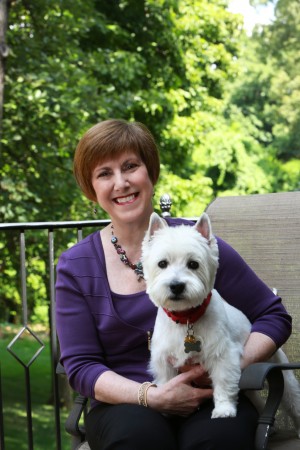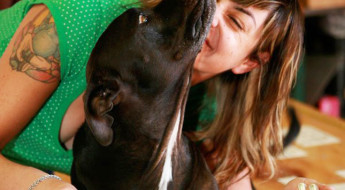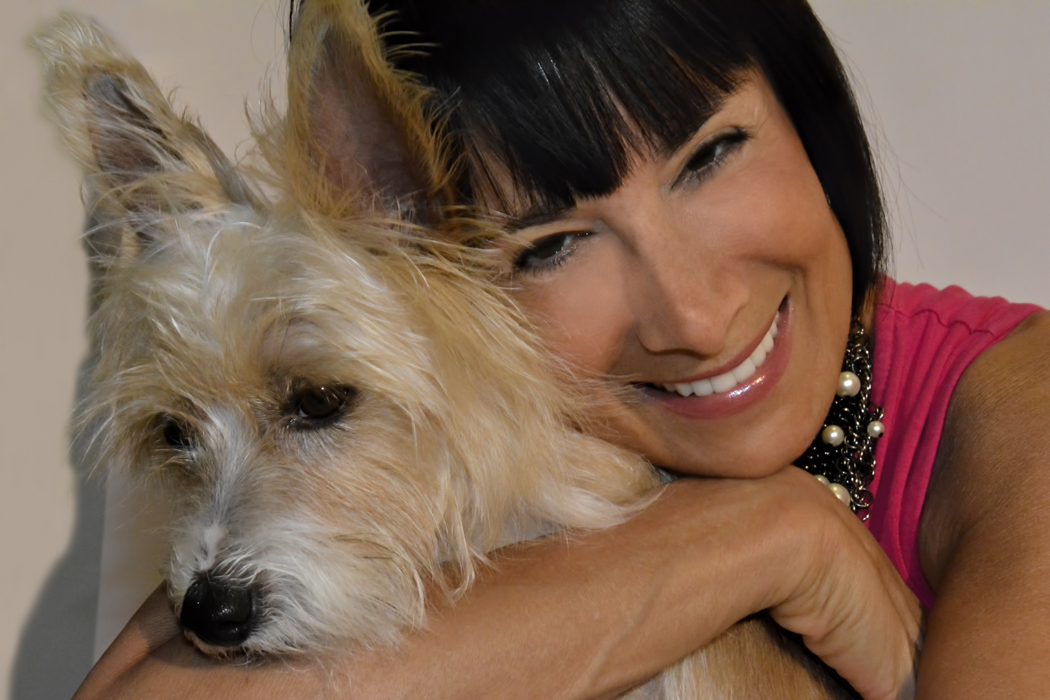Part Two – Dog Behaviors Explained in Plain Talk by the Experts: Decoding Your Dog Interview
Ever wondered how your dog thinks? Are you unsure about how to deal with a behavior issue? There’s a new book called Decoding Your Dog, written by board-certified animal behaviorists, Drs. Debra Horwitz and John Ciribissi, and edited by nationally-syndicated pet journalist, Steve Dale, that can help. It’s easy to read and has great information on everything from choosing the right dog or adding a second dog, benevolent training tips, and solid, science-based evidence on how to treat things like aggression, separation anxiety, even advice on slowing aging in senior dogs. It covers a lot more, too. For me, it’s been a great resource around issues with our new rescue, Jasper, who has fear-based aggression and separation anxiety. And, it’s refreshing to have some common dog behaviors explained in plain talk I can understand, but still based on solid research from the experts. You can find the review I did on the book here. While reading Decoding Your Dog was great, I wanted to get a bit more info from the source to, hopefully, help readers who have similar problems with their dogs. What follows is the first of a two part interview with Dr. Horwitz, who shed some light on why our pups do what they do. Like the book, you can skip around and read in digestible bites! 🙂
The interview
BaS: I’m going to jump right in, because I was a bit confused about this, so other people might be, too. How do you know when it’s appropriate to seek help from a behaviorist or from a trainer, when it’s not a clear cut situation?
DDH: Issues that have aggression or profound anxiety associated with them, these are not training issues, and they need to be treated by a veterinarian or veterinary behaviorist. Unruly behavior – dogs that are pulling on leashes, jumping on people, barking at the doorbell too much, but without aggression, those are training issues.
BaS: What’s your view on how our dog’s personality type affects how we train them?
DDH: Everything works some of the time and nothing works all the time. Anyone that works with a dog, or a child or adult, for that matter, and wants a change of behavior has to understand that individuals learn differently. You need to find out the type of presentation that works best for the type of organism you’re trying to have an impact on. So, personality matters to some degree, but so does the flexibility of the person who’s administering the training. Know your dog and know enough about the way to change behavior, not to be wedded to a single way to do any one thing.
If there’s one thing I can leave your readers with, it’s this: if you take your dog to a trainer or someone who’s working on their behavior, and they say this is the only way that we can teach your dog to do this, I would be very wary. There’s usually more than one way. Maybe this one way is integral to teaching the dog what we want and we’re going to have to work up to it, but you need to have a lot of tools in your toolbox, because each individual dog learns differently.
BaS: How do you know when behavior is genetic vs. environmental?
DDH: Everything has a genetic component, but what we don’t know but try to balance, is how much of the behavior is trait-based, meaning is this an inherent trait in the way this dog looks at the world, or how much is state-based – the environment this dog finds himself in, the training that’s taken place in the past or his past experiences. We look at how a dog responds across a vast array of situations to determine this. For example, if you have a dog that is anxious and fearful of a wide array of things and circumstances, then it may well be that this dog is more prone to respond to the unfamiliar in a fearful and anxious way. It doesn’t mean it can’t get better, but it tells you there might be limits to what you can do and might call for one set of tools to manage it. Here’s an example of state-based behavior. I worked with a dog who had a very scary experience while left at home alone. The fire alarm went off and scared him terribly. He decided, from then on, that being left at home alone was very scary. Despite trying to condition him, he was too anxious. But, his traumatic experience didn’t affect him being left alone in someone else’s house or somewhere else. That’s an example of state-based behavior.
BaS: How do you best assess methods of treatment when you don’t know the dog’s background?
DDH: We don’t know what your dog thinks; we only know what he does. So, we concentrate on what the dog does, what he looks like when he does it, how he recovers from these behavioral changes and what the triggers are. What made the dog the way he is is relevant in some sense, but we can’t go back and undo that. Maybe Jasper, for example, came from a environment where he never had to go outside for a walk to eliminate, so his exposure at a critical time was very limited. I can’t change that now, and it’s not really relevant to the way I’d go about treating him.
BaS: Isn’t the behavior going to be different if it’s a socialization issue vs. an abuse issue, let’s say?
DDH: No. It’s very common for people who adopt shelter dogs with fear-based aggression to tell us they were abused. It’s very rare that there’s substantiation that has taken place. In Jasper’s case, it sounds like his exposure was very limited. The prime socialization period in dogs, when you can introduce them to the most things and they are the most receptive, is between six and 14 weeks. Every dog will be socialized during that time. What they are socialized to could be limited. So, to say Jasper wasn’t socialized is incorrect. Jasper may have not been socialized to the things in his current environment in a way that makes sense to him.
BaS: Very interesting. So, once that prime period has passed, can we change behavior or “socialize” them?
DDH: Yes, but not in the same way as during that prime period. That ship has sailed.
Adding a second dog to the family
Many of my pet industry friends have multiple pet homes. For us, adding a second dog to ours was a first. Did we make some mistakes? Is Jasper the best match for Sophie? For any of my readers who might be considering adding a second dog to their household, I hope this info is helpful.
BaS: Does gender matter when choosing a second dog?
DDH: It is likely that gender matters less than the personality of the dogs involved. The research that we have on pairs of dogs in a home that fight shows that female/female pairs are more common. These are cases presented to veterinary animal behaviorists, but they don’t vastly outweigh male/male pairings, either. What we’re often dealing with in these situations is a mismatch of personalities, more than gender.
For example: We’ve had roomates or worked with people in offices. Some we like and some we don’t. With our dogs, we’ve created an environment where they don’t have a choice. Just like the office, different people resolve conflict in different ways. It’s the same in a household with dogs. If you have a quiet, reticent dog, who would rather sit quietly at the window than play a rousing game of chase or ball, and you bring home a dog that is a go get ’em, I can chase a ball until three of my four legs fall off kind of dog, they’re not going to be the best of buddies, unless they can communicate to each other what their needs are and it’s respected.
BaS: That seems to be the case with Sophie and Jasper. He plays like a locomotive train. She doesn’t. But she seems to enjoy it for a time. When she’s had enough, she’ll snarl fiercely – there’ no real biting that goes on – but he’ll get the message and back off.
DDH: That is totally appropriate. And, you’ve done a good job allowing that to happen. Sometimes, dogs fight in a household because they haven’t been allowed to communicate with each other properly. Humans don’t like hearing dogs make those play fighting loud noises. They think that’s a prelude to a real fight, and sometimes it is. But, if an owner intervenes when there is play fighting going on, and neither dog is in real distress, in Sophie and Jasper’s case, Jasper doesnt have the opportunity to learn in dog language that his behavior isn’t appropriate, and Sophie learns that when Jasper is playing too rough, she’s not supposed to let him know it. You take away the dog’s ability to communicate important information to each other about their relationship. Sophie can become more anxious about play with Jasper and things can devolve from there.
BaS: We only intervene when we see Sophie run under the sofa and she needs a break. Then, we’ll pull him off, put him on a leash and keep him with us.
DDH: Right. That’s exatly what you should do. And, redirect him to something else – a bully stick, toy, something positive.
BaS: For those readers who might be considering adopting a dog from a shelter, how accurate is temperament testing in a shelter environment?
DDH: They’re really behavioral evaluations, not temperament tests. What they’re looking for is some indication of how safe the dog is, the reactivity level of the dog. Most shelters do not test the dogs the day they come in. They do try to give them a little time to acclimate, and many shelters test them more than once. Some research has been done on dogs and behavioral testing in shelters. Dr. E’Lise Christensen [who contributed information to this book], did research that showed that some dogs, who passed the testing in the shelter, could then go on to show aggressive behavior when they were in their adoptive home. This is because temperament tests do not do well in testing for certain types of aggressiveness, mostly fear-based aggression towards strangers, territorial aggression and the types of issues you’re dealing with with Jasper. These behaviors are not easily tested in a shelter enviroment because no one’s trying to put him in an elevator, walk him through a lobby and generally expose them to specific lifestyle situations they might encounter outside the shelter. Other testing showed dogs who exhibited food-based aggression in the shelter, but did not in their forever home or, if they did, it was easily managed. They’re not fool proof.
Training tips
I wanted to know if speaking to our dogs, something I’ve always done with mine, or if the environment they live in with us has any effect on training or on being well-adjusted.
BaS: I’ve always talked to the dogs I’ve had in my life. And they seem to understand. Can language or how we talk to our dogs help in training or managing them?
DDH: Dogs can learn between 250 – 300 words; some can learn more. Chase, a Border Collie, knows over 1000 words. But, dogs also respond to vocal information. The story I often use in my lectures is, I used to have a Labrador Retriever named Chelsea. Like most Labrador Retrievers, eating was the highlight of her day. If you asked Chelsea, ‘Is it time to feed the dog?’, she would jump up on the counter and start barking. If you said, ‘Is it time to weed the hog?’ with the same inflections in your voice, she would jump up on the counter and start barking. So, you could manipulate things based on tone of voice. The dog I have now, his name is Oscar and he’s a West Highland White Terrier. He knows the phrase, ‘I’m going to pick you up.’ You can see a change in his body, it relaxes, and he let’s me pick him up. I think it’s absolutely true that our dog’s learn what we say, but they watch what we do, as much if not more.
BaS: For those of us living in big cities, is there any science-based conclusions that this amount of stimuli could be too overwhelming and detrimental to dogs?
DDH: I’ll go back to the issue of temperament and personality. I think sometimes we do small dogs a disservice by picking them up all the time, because we don’t allow them to experience what’s going on on the ground. For dog’s that live in the city, it’s very importnat for owners to be aware of what their dogs are experiencing. It’s the idea of ‘I’ve got your back.’ If you’re on your mobile device while walking your dog, you’re not watching as to whether a bigger dog or another dog that could be threatening is approaching, and that you need to move your dog to protect him. Because they’re leashed to us, the dog’s ability to respond and escape is limited, and we need to be involved and cognicient of what’s being presented to them.
I understand that having to walk your dog in the city is a time commitment, so what I tell people is this: take elimination walks and sniff walks. An elimination walk is when you leave your apartment or house and you let your dog know the first thing you’re going to do is you’re going to empty your bladder and empty your bowels. And, if time permits, we are going to walk.
BaS: How do you teach them to go to the bathroom fast?
DDH: One way to do that is via verbal control. You stand by the spot where the dog needs to go, and you say whatever you decide that means go potty. When they do, you reward them with food. Elimination is rewarding in and of itself for a dog, but that’s not what you’re rewarding. You’re rewarding do it here and do it now. In the end, it’s worth the extra boring time standing by the spot until it actually happens until they get it, so you can then walk your dog to that spot and say ‘Go pee,’ walk a few feet and say, ‘Go poop,’ and they do!
BaS: Wow, that’s like, ‘Died and went to heaven,’ advice! Rain, snowstorms, loud noises like the 4th of July we just went through…what a great tool that would be!
Dr. Horwitz gives some great advice on handling fear-based aggression, separation anxiety and helping our senior dogs. Come back tomorrow for Part Three, the final segment, of my Decoding Your Dog interview.
Where to buy: Amazon
Price: Hardcover – $20.53; Kindle – $9.45; MP3 CD – $26.99; Audible book – $23.95
What are your behavioral challenges with your dog? Tell me about it in the Comments.
(Disclosure: affiliate links)












